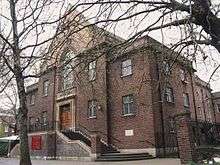Whitefield's Tabernacle, Tottenham Court Road
 | |
| Location | Tottenham Court Road, London |
|---|---|
| Country | United Kingdom |
| Denomination | Congregational / United Reformed |
| Architecture | |
| Years built | 1756, rebuilt 1957 |
Whitefield's Tabernacle, also called Tottenham Court Road Chapel, is a church on Tottenham Court Road, London, England. It is now the home of the American International Church.
History
The first chapel on the site was built in 1756 for the Evangelical preacher, George Whitefield. It was enlarged in 1759. John Wesley preached a sermon "On the death of the Rev Mr George Whitefield" both here and at Whitefield's Tabernacle, Moorfields, in 1770.[1]
The original chapel stood on the west side of Tottenham Court Road, between Tottenham Street and Howland Street, surrounded by fields and gardens. Its foundation stone was laid by Whitefield in June 1756, and it opened for its dedication service on 7 November of the same year. Its initial popularity led to plans being drawn up for enlargement, and these were quickly put into effect in 1759. Beneath the chapel, a vault was also prepared; it was Whitefield's hope that he could be interred here along with the two Wesleys, but he died and was buried in Newburyport, Massachusetts.[2]
In 1890 the building was taken down and re-erected as Whitefield's Central Mission. In 1895 the coffins buried in the crypt (including Elizabeth Whitefield, but excluding the lead coffin of Augustus Toplady) were moved to Chingford Mount Cemetery in north London.[3]
From 1903 to his death, the Church's Minister was Silvester Horne, the father of the broadcaster Kenneth Horne.
On Palm Sunday 1945 the church building was destroyed by the last V-2 rocket to fall on London. A new chapel was built in 1957, and the grounds became a public thoroughfare.
Current use
Since 1976 the chapel has been the home of the American International Church,[4] having been offered to them by the United Reformed Church when they were forced to move from their building in North Audley Street in 1972. Currently, it houses both the London Chinese Lutheran Church[5] and the American Church in London. The adjoining grounds have recently had a series of interpretive panels designed for them by Groundwork Camden, with funding from the Heritage Lottery Fund. These depict various scenes in the history of the chapel, Whitefield's links to Selina Hastings, Countess of Huntingdon, and the abolition of slavery as represented by Olaudah Equiano who came to be associated with Calvinist Methodism, and came to live close to Whitefield's Chapel shortly before his death.
Notable burials
References
- ↑ Wesley, John. "Sermon 53: On the Death of the Rev. Mr. George Whitefield". General Board of Global Ministries. Retrieved 12 March 2013.
- ↑ Schlenther, Boyd Stanley (2010). "Whitefield, George (1714–1770)". Oxford Dictionary of National Biography (online ed.). Oxford University Press. doi:10.1093/ref:odnb/29281. (Subscription or UK public library membership required.)
- ↑ 'Tottenham Court Road (west side)', Survey of London: volume 21: The parish of St Pancras part 3: Tottenham Court Road & neighbourhood (1949), pp. 66-74. Date accessed: 16 June 2010.
- ↑ American Church in London retrieved 23 May 2014
- ↑ London Chinese Lutheran Church retrieved 23 May 2014